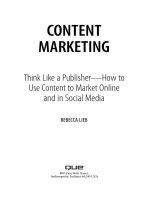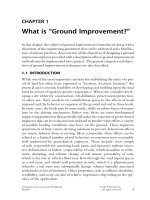Content marketing think like a publisher chapter 1 what is content marketing, anyway
Bạn đang xem bản rút gọn của tài liệu. Xem và tải ngay bản đầy đủ của tài liệu tại đây (283.72 KB, 4 trang )
1
What Is Content
Marketing, Anyway?
“Your customers have chosen the moment—all you have to do is be ready.”
Have you ever picked up a company’s brochure or flyer?
Watched an infomercial or a shopping channel on television? Ordered a product DVD explaining the benefits of a
new mattress or a vacation destination? Leafed through a
company newsletter? Read the little comic strip in a
packet of Bazooka bubble gum?
All these are a few (but by no means an exhaustive list)
of the ways companies use content to market their products and services to customers and to prospective buyers.
Content marketing, in other words, is nothing new.
Companies having been creating and distributing content
for many years, both to attract new business and to retain
existing customers. However, here’s the point of differentiation from more traditional forms of marketing and advertising: Using content to sell isn’t selling, or sales-ey. It isn’t
advertising. It isn’t push marketing, in which messages
are sprayed out at groups of consumers. Rather, it’s a pull
strategy—it’s the marketing of attraction. It’s being there
when consumers need you and seek you out with relevant, educational, helpful, compelling, engaging, and
sometimes entertaining information.
2
Part I
Content Marketing Basics
When customers and prospects come to you, rather than the other way around, the
advantages are obvious. They’re interested, open, and receptive. Your customers
have chosen the moment—all you have to do is be ready. And it spares you much of
the headaches and expense of outreach marketing efforts:
• Media planning and buying.
• Direct mail dumps.
• Spraying and praying in an era in which browsers can be configured to
block ads, spam filters can be sending your email campaigns into oblivion, digital video recorders are making TV spots optional, and consumers are emptying much of the content of their mailboxes into the
Recycling Bin.
There’s really no debate over the benefits of tune-in versus tune-out, of pull versus
push.
A Roper Public Affairs poll found 80% of business decision makers prefer to get
information about a company from articles rather than from ads. Some 70% say
content marketing makes them feel closer to the sponsoring company, and 60%
believe company content helps them make better product decisions.
Content marketing aids in brand recognition, trust, authority, credibility, loyalty, and
authenticity. Content marketing can help accomplish these tasks for a variety of constituencies, and on several levels: for the organization it represents, for a company’s
products and services, and for the employees who represent the business or service.
Content marketing creates value and helps people. It answers questions and provides foundational information. It makes customers and clients more educated and
informed, so they feel they can make purchase decisions, or, in organizations, to
recommend purchases to colleagues or superiors. It’s used by marketers large and
small and by those selling business-to-business (B2B) and business-to-consumer
(B2C). Some are using content to augment traditional advertising campaigns.
Others are leveraging content to completely replace more traditional forms of
advertising and marketing. Content can spark customer engagement at all stages of
the buying cycle, including helping to establish an ongoing relationship when a
prospect becomes a customer. Content can reinforce an existing relationship,
inspire upselling, cross-selling, renewals, upgrades, and referrals.
Digital Changed Everything
Although content marketing is hardly new—after all, businesses have been publishing newsletters and brochures practically since the advent of the printing press—the
rise of the Internet and other digital channels, particularly social media, has significantly lowered the bar (and the costs) of leveraging content to profitably attract
clients and prospects.
Chapter 1
What Is Content Marketing, Anyway?
3
Websites. Blogs. YouTube. eBooks. Downloadable whitepapers. Twitter. Facebook.
LinkedIn. Google+. Search engines. All these channels (and many, many more)
remove many of the hard cost barriers that were once a mandatory part of creating
and disseminating great content. No more paper, printing, shipping, warehousing,
postage, filmstock, processing, and developing. Many of the physical and logistical
hurdles to creating and disseminating great content are gone.
Although content marketing may be cheaper thanks to digital innovations, it certainly isn’t free (even if your Facebook account is), nor has digital made it any easier. Consistently delivering quality content to a target audience requires thought,
work, originality, strategy, experimentation, and persistence. A plethora of potential
outlets for content online (the options seem to multiply every day) add complexity
to the choices you must make about what content to create, in what form, and how
to disseminate it—not to mention measuring its effectiveness. One thing is certain:
Digital channels overwhelmingly account for the preponderance of content marketing outlets, as Figure 1.1 illustrates.
0
20
40
60
Social Media
(other than blogs, i.e. Twitter, Facebook)
72%
63%
63%
Enewsletters
Blogs
White Papers
48%
48%
46%
42%
Article Marketing
Case Studies
Online Video
Custom In-Person Events
Microsites
Promoting Content in Traditional Media
Custom Virtual Events (webinar/webcasts)
eBooks
Podcasts
Print Newsletters
Digital Magazines
Custom Print Magazines
Mobile Content
80
31%
31%
31%
26%
19%
17%
16%
14%
10%
10%
Figure 1.1 Content Marketing Usage By Tactic.1
2
“B2B Content Marketing Benchmarks, Budgets and Trends” MarketingProfs/Junta42
100
4
Part I
Content Marketing Basics
Research from this same
MarketingProfs/Junta42 study, conducted in
2010, found that 60% of marketers planned
to increase content marketing spending in
the coming year. Content already accounts
for more than 33% of marketing budgets—
often double that in smaller organizations.
Overwhelmingly, all these efforts and budgets are flowing into digital channels.
“Be prepared to
experiment. Be
prepared to fail—
but make sure
your learn from
those failings.”
The aim of this book is to help you get a
handle on content marketing in digital channels. I examine tactics, strategies, and the myriad channels available to content
marketers. I provide case studies from brands both large and small in the hope that
they enlighten or inspire.
You should bear in mind that when it comes to content marketing, there really are
no rules. There are best practices, to be sure. Aside from common sense notions
(such as checking spelling and grammar; if it’s a video, it should probably contain
moving images and audio), there are no hard and fast rules, only guidelines. The
content that works to support your business won’t be what works for another company with a different audience, offering, and personality.
If there’s a single thing that deserves to be said before you dive in, it’s this: Be prepared to experiment. Be prepared to fail—but make sure your learn from those failings. And above all, have fun. Creating interesting, compelling, original,
educational, diverting, immersive, entertaining, and attractive content can be just as
valuable and inspiring for the creator as it is for its intended audience.
So have fun! And learn a lot.









